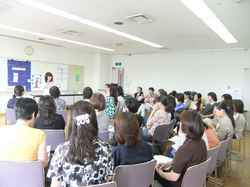 We were delighted to have many teachers from Tokyo and Hiroshima as well as the Kansai and Shikoku area on June 30th. It was really great to see everyone and to be able to learn together.
We were delighted to have many teachers from Tokyo and Hiroshima as well as the Kansai and Shikoku area on June 30th. It was really great to see everyone and to be able to learn together.
We started our meeting with an ice breaking activity, shouting out what our area is famous for with gestures.
At the first part of our meeting, we demonstrated a full 50-minute lesson as we did in March. We decided to do this because many teachers who came in March had written that they would like to see it again in the questionnaire and also we received many e-mails from other teachers as well.
The target students were 3rd graders who had been learning English for four months.
This lesson was the first week of the fifth month. The main purpose of the lesson was to introduce how to say the Family members and how to use the pronouns ‘He’ and ‘She’. The following describes how the lesson was done.
1. Warm Up Song
The students sang the song, “The Seven Days of the Week”. Here the students were reviewing the days of the week with gestures. This familiar song starts from ‘Sunday’. But the students enjoyed the challenge of starting singing from ‘Monday’ or other days.
We did a short activity, using a die with the Days on and when the die showed the same day when the song ended, they said ‘Yay’. If not, they said, ‘Oh, no!’ This was a good opportunity to introduce those expressions as well.
2. Greeting & Attendance
A leader was chosen from the students with the teacher giving several hints, such as “Today’s leader can throw a basketball.” Those who matched the hints had a chance to be the leader. This small section, which takes only a few minutes, can be a very lively Listening Activity. By using the sentence pattern with new vocabulary, this can be an ideal section for INPUT.
3. Review
It is always important to review from the very first lesson. Here we introduced some skills and tips in doing a quick review from the very first lesson. The following is what we did*
1) ‘Ask the Leader’
After calling the roll, the leader was asked some personal questions that the students have already learned.
2) ‘One Minute Rush Game’
Using the IIEEC Question & Answer cards, the students asked questions to each other. The cards were selected so that they covered what the students have already learned with the textbook. Students get into pairs as quickly as possible and only the one who asks first can ask the question. When they ask three people, they go back to their seats.
3) ‘He can, She can 1, 2, 3! Game’
This is another effective Learning Activity where students collect as many cards as possible while they Ask and Answer in pairs. The IIEEC Action Cards were used for this activity.
4 TELL
The “TELL” section is where students say things freely using the language they have already learned. This time we made an enlarged copy of Let’s Go Picture Dictionary. As we always say, the important thing is that the first words must come from the students. In other words, teachers do not ask questions or give any hints. Please try this in your lessons and see how much your students will enjoy telling their comments.
5 Role Play
Then we did a Role Play using the expression “This is my friend.” The students already learned this expression in the previous unit. After reviewing the expression briefly, the students were divided into groups of three. They pretended to meet on opposite sides of a busy road as they wait for the traffic light to turn green. It was fun to use our imagination and to think of what to say in this kind of situation.
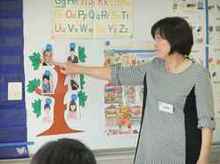 6 Main Lesson
6 Main Lesson
The aim of the lesson presented was how to introduce the vocabulary of the family members and reinforce how to use the pronouns ‘He’ and ‘She’. Using some pictures of famous people, an ideal family was introduced. This was the section where the skills of the MAT Practice System were used. Checking the pronunciation at the very beginning, we followed the steps and Drilled with a good speed and rhythm. This helps students to concentrate on what they are learning. To use Word Cards can help students confirm what they are saying. As we go on to the Group Practice and the Pair Practice, the students gradually build their confidence in using the language by themselves. Eventually they will be able to do the Question and Answer sequence without the teacher’s help. Isn’t that great!!
7 Reading &Writing
The main focus for this section was to introduce the sounds of the Short Vowels. With the MAT Phonics, we use gestures for the short vowels as well. We also introduced a short activity. In this way the students can connect the sound and the letter and the gesture. It seems that many Japanese students have difficulties in recognizing the sounds of the short vowels. We believe it is necessary to have students practice the short vowel sounds repeatedly so that they will have less stress in reading and writing later on.
8 One Minute Review
Using the pictures of the famous people again, the students were to ask the question
‘Who is he/she?’ Please try to do this quick review so that your students will remember better.
After the demonstration of how to do a Full Lesson, we had a section called ‘It’s your turn’, where the participants took turns to be the teacher and check the steps.
We introduced a song and activities that can be used for summer events in the latter part of the workshop.
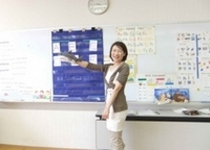
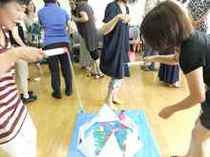 The song ‘Baby Shark’ can be a great sensation if you sing it at summer camp or a summer party. Actually there are many versions of the song which you can find on You Tube. We also introduced Activities: “ABC Phonics Fishing Game,””6 Islands Quiz,” and made a craft of a shark as well.
The song ‘Baby Shark’ can be a great sensation if you sing it at summer camp or a summer party. Actually there are many versions of the song which you can find on You Tube. We also introduced Activities: “ABC Phonics Fishing Game,””6 Islands Quiz,” and made a craft of a shark as well.
Finally, we had fun listening to the story, “The Three Little Fish and The Big Bad Shark’ by Ken Geist. 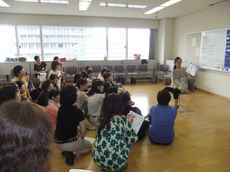
We hope that the skills and the tips we introduced will help you and your students have an enjoyable and fruitful lesson.
We hope to see many teachers at our next meeting in September.